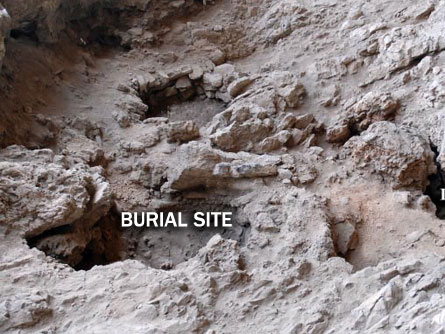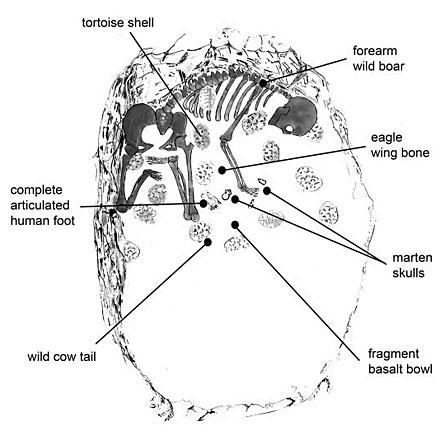An ancient healer reborn
Excavations in Israel reveal one of the oldest known graves of a shaman, from 12,000 years ago
The graves of people who died 12,000 ago rarely contain a woman’s skeleton pinned down in an unusual position by large stones, accompanied by a menagerie of animal remains and another person’s foot. Yet that’s what archaeologist Leore Grosman of Hebrew University of Jerusalem and her coworkers recently discovered in a small Israeli cave called Hilazon Tachtit.


Closer analysis shows that this grave holds a shaman, one of the earliest ever excavated, the researchers report in an upcoming Proceedings of the National Academy of Sciences.
In traditional societies, shamans are thought to communicate between the human and the spirit worlds. These specially designated individuals are considered to possess spiritual, magical and healing powers. Shamans are typically buried in elaborate ways that mark their privileged status and destination for a special afterlife.
“There is no doubt that this woman had a special social position, and the most viable interpretation of this burial is that it was for a shaman,” Grosman says. The grave offers some of the earliest physical evidence of religious and spiritual belief, she adds.
Her team uncovered the woman’s burial in 2005 and 2006, amid individual and group graves of at least 27 other people in a cemetery that belonged to a prehistoric Natufian settlement. The Natufian culture, which lasted from roughly 15,000 to 11,500 years ago, played a central role in the transition from foraging to farming and was the first known society to live in year-round settlements. Burials of the dead increased dramatically in number among the Natufians, indicating that these people assigned much symbolic importance to treatment of the dead.
An earlier radiocarbon study of finds at Hilazon Tachtit concluded that activity had occurred there between 12,400 and 12,000 years ago. That stretch of time was marked by a cold, dry climate in the region and relatively small, dispersed Natufian settlements.
“The most parsimonious explanation of this unique grave treatment for a Natufian person is that this woman was a shaman,” comments Harvard University archaeologist Ofer Bar-Yosef.
Debby Hershman, curator of prehistoric periods at the Israel Museum in Jerusalem, followed Grosman’s excavation with keen interest and plans to display some of the finds in 2010. “The burial of the shaman from Hilazon Tachtit cave is one of the most important discoveries associated with a prehistoric cult,” she says.
Archaeologist Donald Henry of the University of Tulsa suspects that Hershman is right but notes that the Natufian woman may instead have been someone who achieved exceptional status in a culture that was just beginning to develop levels of social prestige and political power.
After removing a triangular limestone slab atop the woman’s grave at Hilazon Tachtit, the researchers found her skeleton lying in a limestone-tiled oval enclosure. Her body lay on its side, with her back and right upper-leg resting against a wall. Her legs were spread apart and folded inward at the knees. Large stones had been placed on her head, pelvis and arms, apparently to hold them in place.
Grosman estimates the woman died at about age 45 and stood just under 5 feet, or 1.5 meters, tall. The skeleton displayed spinal and pelvic deformities that would have caused the woman to limp or drag her feet.
Next to her left leg lay a stone bowl and the complete skeletal remains of a foot from an adult who was much larger than the woman was.
Most remarkably, Grosman says, 50 complete tortoise shells had been placed in the grave. Body parts of other animals rarely buried with Natufians also lay nearby — a wild boar, an eagle, a cow, a leopard and two martens.
The Natufians went to great lengths to construct a unique grave at the top of a 150-meter slope in order to bury a relatively old and disabled woman, Grosman says.
Animals placed in the grave have been mentioned in many modern and historical accounts of shaman burials, she notes. Ancient community members perceived the woman as having a close relationship with these animal spirits, in Grosman’s view. Many descriptions of shamanism have noted that healing and spiritual powers have often been attributed to physically disabled individuals.
Researchers have found only a handful of possible shaman graves at prehistoric sites. Much skepticism surrounds the claim that a roughly 60,000-year–old Neandertal, unearthed in Iraq’s Shanidar cave in 1960 and nestled among clumps of pollen from various flowers, was a shaman. Several central European sites have also yielded evidence of shamanism, including a 25,000-year–old hut containing artifacts thought to have belonged to a shaman.
In 2006, researchers re-examined a 9,000-year–old woman’s skeleton and grave offerings from a German site and concluded that she had been a shaman. Skull abnormalities would have caused the woman to experience altered states of consciousness that were seen by others as signs of spiritual powers, the investigators suggested. The team bases this idea on reports of similar skeletal deformities in modern people, abnormalties that cause numbness, itching, tingling and other unusual sensations.







